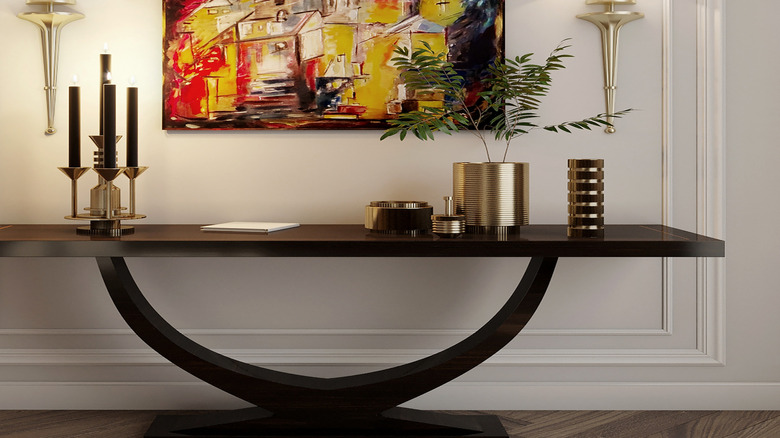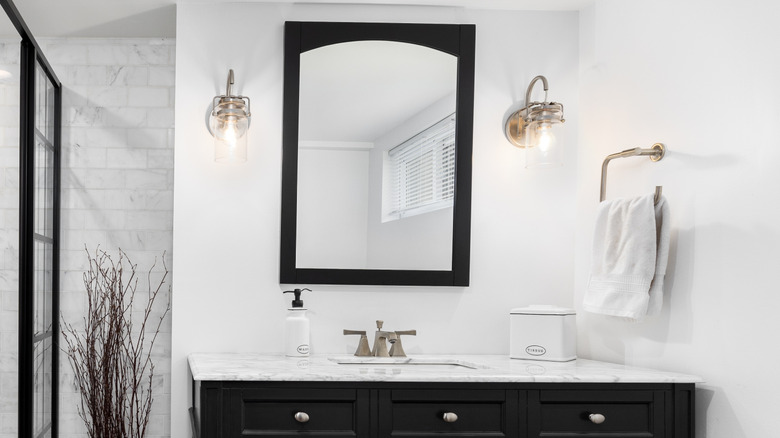The Renter-Friendly Solution For A Room With No Hard-Wired Lights
Being stuck in a dark or dimly lit room, especially if your space is cramped with many edges to trip on, is a recipe for disaster. While a permanent solution often requires upgrading the existing lighting with new hard-wired fixtures, such a process might not be a viable option for everyone. For instance, if you live in a rented space, you might be prohibited from changing the electrical wiring without the owner's permission. And even if you have their permission, upgrading a space that isn't yours means that your investment will be lost the moment you decide to leave. That's why it's worth it to consider other creative ways to revamp your light fixtures, like installing wireless sconces.
Because the light bulb in a wireless sconce is usually battery-operated or rechargeable, you don't need any hard-wiring to use them. And in most cases, you won't even need a power outlet nearby. They can be mounted on any wall with minimal to no damage. Some come with an adhesive base that you only need to peel and stick on your wall. This means that you get to save money on both installation and wiring. Wireless sconces are suitable for all budgets, as their prices can range from $20 to $135. They're also portable, so you can take them wherever you move next.
The benefits of using wireless sconces as a renter
Wireless sconces can be extremely versatile and practical. Similar to traditional sconces, they come in a range of styles and features, which makes it easy to find the perfect wireless sconce that fits your home decor and lighting needs. Being a battery-powered light source also means that they can be the perfect emergency light in case of a power outage. Additionally, some models are built to be especially energy-efficient with LED bulbs and rechargeable batteries that can last up to 160 hours on a single charge. Many of these models also come with a remote control or an accompanying phone app that allows you to adjust the light's brightness and color temperature, or even set a timer to automatically turn it off after a set period.
If you're worried about tripping in the dark while looking for the remote, some advanced models come with motion sensors that turn them on the moment you step into the room. Moreover, some come with a rechargeable light bulb powered by a USB-C charging cable. These bulbs fit inside sconces' frames in a similar way to regular bulbs, which allows you to simply unscrew them and fit them in any compatible light socket. This is a hidden feature because you can use your wireless sconce's bulb on an old light fixture if it is no longer working, its cord isn't long enough to reach a socket, or you simply need an easy way to save on electrical bills.
Where to place your wireless sconces
Whether to improve illumination, serve as a mood light, or simply to add aesthetic value, wireless sconces are one of the best cordless lighting ideas to brighten your home. If you have a long hallway that lacks sufficient lighting, adding two or more sconces, spaced for perfect illumination, down the walls is an easy fix. You can also use them on either side of your bed as a replacement for traditional nightstands. Another good place to install wireless sconces is on each side of your TV in your living room for extra light without the extra cables. Additionally, some wireless sconces that offer a daylight or neutral light mode can be placed over your work desk for enhanced concentration and productivity. They can also be a good addition around vanities or on top of a fireplace.
No matter where you decide to place your wireless sconce, there are a couple of things that you need to be aware of. Even with their adjustable brightness, some wireless sconces, regardless of their price range, only provide low to moderate illumination, about 100 to 300 lumens for each sconce installed. For reference, even a 50-square-foot living space needs a total of 1000 lumens of lighting. You also need to be aware that since you'll need to recharge the bulbs at least once a week, installing multiple stationary sconces in one place can make the recharging process more difficult.


